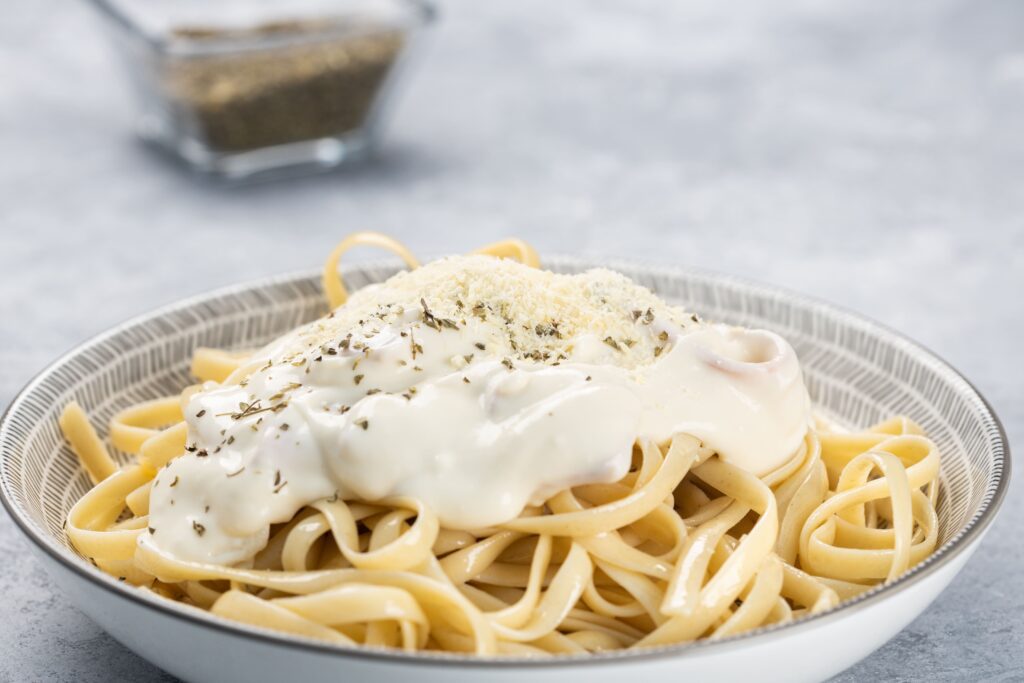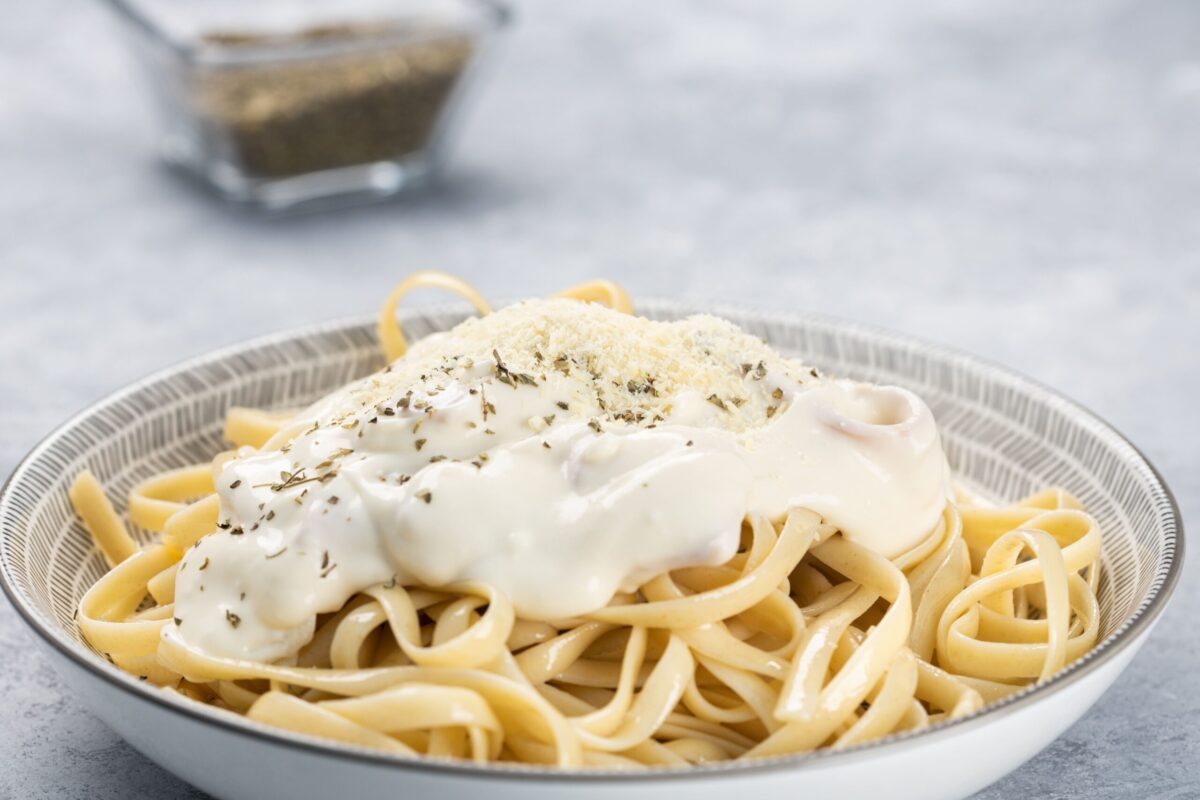Alfredo sauce is a luxurious, creamy favorite in Italian-American cuisine. Known for its velvety texture and indulgent flavor, this classic sauce is often paired with pasta, casseroles, or even as a base for creative dishes like pizzas. However, achieving the perfect thickness in Alfredo sauce can sometimes be challenging. So, what’s the secret to making Alfredo sauce thick, rich, and irresistible? In this detailed guide, we’ll explore essential ingredients, expert techniques, and practical solutions to help you create the perfect Alfredo sauce.

Understanding Alfredo Sauce and Why Thickness Matters
What Makes Alfredo Sauce Special?
The traditional Alfredo sauce recipe uses butter, heavy cream, and Parmesan cheese to create its signature richness. These simple ingredients must be combined carefully to achieve the perfect consistency. Modern versions often include garlic, nutmeg, or cream cheese to enhance the flavor.
For those comparing creamy sauces, explore Which Is Healthier: Carbonara or Alfredo Sauce? to better understand how Alfredo differs in preparation and nutritional value.
Why Thickness Is Essential
- Improved Texture: A thick Alfredo sauce clings beautifully to pasta, ensuring every bite is flavorful.
- Balanced Flavors: Proper thickness prevents the sauce from feeling overly heavy or watery.
- Enhanced Versatility: Thick Alfredo sauce works well in casseroles, pizza bases, and baked dishes.
Thin or runny Alfredo sauce can undermine the dish, making it less satisfying. Let’s explore the secrets to getting it just right.
The Secret Ingredients for Thick Alfredo Sauce
Achieving the perfect thickness begins with selecting the right ingredients.
1. Parmesan Cheese
- Use freshly grated Parmigiano-Reggiano for its melting properties and rich, nutty flavor.
- Pre-shredded cheese contains anti-caking agents that can hinder smooth melting. Opt for fresh cheese to avoid lumps and ensure a creamy consistency.
2. Heavy Cream
- Heavy cream is key to a naturally thick Alfredo sauce due to its high fat content. Avoid substituting with milk or low-fat options, as they won’t provide the same luxurious texture.
- Using double cream or whipping cream can further enhance the sauce’s body.
3. Butter
- Butter not only adds richness but also helps emulsify the sauce, binding the ingredients for a smooth finish. Unsalted butter is preferable for better control over the sauce’s saltiness.
4. Starch for Thickening
- Cornstarch Slurry: Mix 1 tablespoon of cornstarch with 2 tablespoons of cold water or broth to create a slurry. Whisk it into the sauce over low heat.
- Flour Roux: Cook equal parts butter and flour to form a roux, then slowly whisk in the sauce for a thicker consistency.
5. Egg Yolks
- Tempering egg yolks (whisking them with a small amount of warm sauce before adding back) adds creaminess and a custard-like texture to the Alfredo sauce.
For additional inspiration, check out recipes like Chicken Alfredo Pasta Casserole, which showcases how the perfect sauce enhances a dish.
Techniques for Perfect Alfredo Sauce
Even with the best ingredients, the method is equally important. Here’s how to ensure your sauce turns out perfectly every time.
1. Low and Slow Cooking
- Alfredo sauce is delicate. Cook it over low heat to prevent curdling and maintain a creamy texture. High heat can cause the sauce to separate.
2. Proper Whisking
- Continuously whisk the sauce as you add ingredients to ensure even distribution and avoid lumps.
3. Reduction Method
- Simmer the sauce uncovered to allow excess liquid to evaporate naturally. This not only thickens the sauce but also intensifies its flavor.
4. Layering Ingredients
- Add ingredients in stages: Start with butter and garlic, followed by cream, and finish with cheese. This order ensures proper emulsification and prevents clumping.

How to Fix Thin Alfredo Sauce
If your Alfredo sauce turns out too runny, don’t panic. Here are some effective ways to thicken it:
1. Add More Cheese
- Fresh Parmesan or even cream cheese can instantly thicken the sauce while enhancing its flavor.
2. Incorporate Starch
- Use a cornstarch slurry or flour roux. Whisk thoroughly to avoid lumps and cook the sauce over low heat for a few minutes to activate the thickening properties.
3. Simmer to Reduce
- Allow the sauce to simmer gently until it reaches your desired consistency. Stir occasionally to prevent sticking.
4. Puree Vegetables
- Blended vegetables like cauliflower or butternut squash can naturally thicken the sauce while adding a subtle flavor boost.
For a seafood twist on thick Alfredo, try Salmon Alfredo Pasta, which pairs a creamy base with delicate fish.
Common Mistakes to Avoid
Even seasoned cooks can make mistakes with Alfredo sauce. Here’s what to watch out for:
1. Overheating the Sauce
High heat can break the emulsification, causing the sauce to curdle or become grainy. Always cook gently over low heat.
2. Using Pre-Shredded Cheese
Pre-shredded cheese often contains anti-clumping additives that prevent smooth melting. Freshly grated cheese is always the better choice.
3. Adding Too Much Liquid
Excess cream, milk, or broth can dilute the sauce and make it challenging to thicken. Add liquids sparingly and gradually.
Creative Recipes Using Thick Alfredo Sauce
Thick Alfredo sauce is versatile and can be used in a variety of dishes. Here are some ideas:
1. Creamy Chicken Alfredo Bake
Layer cooked pasta, grilled chicken, and Alfredo sauce in a baking dish. Top with breadcrumbs and bake until golden and bubbling.
2. Shrimp Alfredo Pasta
Toss linguine with thick Alfredo sauce and sautéed shrimp. Add a squeeze of lemon for brightness.
3. Vegetable Alfredo Pizza
Use thick Alfredo sauce as a base for pizza, then top with roasted vegetables and shredded mozzarella.
For more vegetable pairing ideas, explore What Vegetables Go With Alfredo?.
FAQs About Thick Alfredo Sauce
What makes Alfredo sauce thick?
The combination of butter, heavy cream, and freshly grated Parmesan cheese naturally thickens the sauce. Techniques like simmering and adding a cornstarch slurry can enhance thickness.
Can I make Alfredo sauce without cream?
Yes, substitutes like milk, egg yolks, or pureed vegetables can be used to create a thick, creamy sauce without heavy cream.
How do I fix overly thick Alfredo sauce?
Gradually whisk in milk, chicken broth, or reserved pasta water to thin the sauce to your preferred consistency.
What is the best cheese for Alfredo sauce?
Parmigiano-Reggiano is the top choice for its rich flavor and excellent melting properties.
Can I prepare thick Alfredo sauce ahead of time?
Yes, but reheating should be done gently over low heat to avoid separating or breaking the sauce.
Conclusion
The secret to thick Alfredo sauce lies in using high-quality ingredients like freshly grated Parmesan, heavy cream, and butter, combined with expert techniques such as simmering and proper whisking. By avoiding common mistakes and experimenting with thickening methods like starch or egg yolks, you can achieve a sauce that’s rich, velvety, and utterly delicious.
For more creative ways to use Alfredo sauce, explore fusion recipes like What Is Marinara and Alfredo Mixed Good?, which blends creamy and tangy flavors for a unique twist.
With these tips and tricks, you’re well on your way to mastering the art of thick, creamy Alfredo sauce. Enjoy creating dishes that wow your family and friends!


1 thought on “What Is the Secret to Thick Alfredo Sauce?”